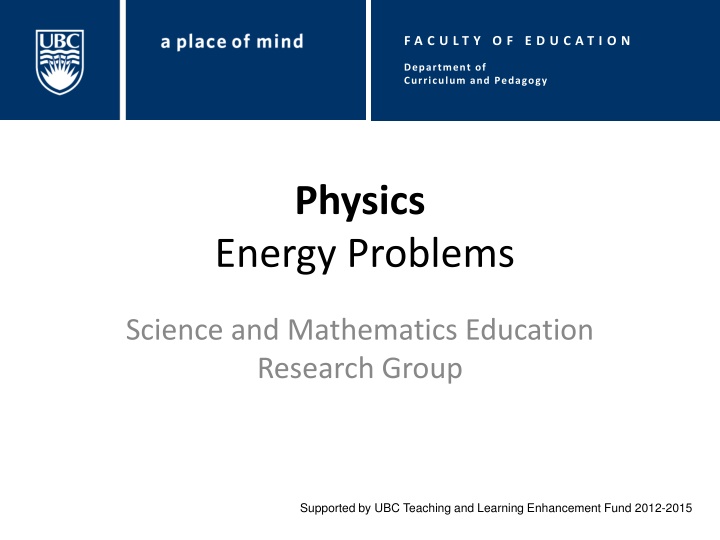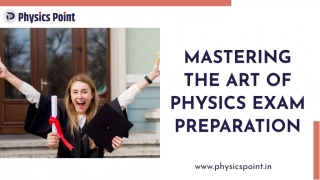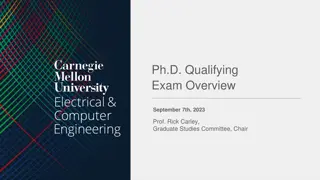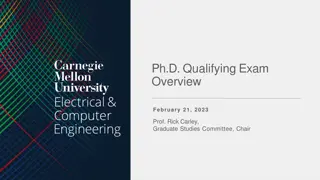Effective Exam Preparation Tips
Maximize your exam success with these proven strategies. Take ownership of your learning journey, understand your unique studying style, manage stress effectively, and harness multisensory learning techniques. Discover various learning styles, revision methods, stress management tactics, and collaborative approaches to boost your exam performance. Empower yourself to excel with practical tips and tools tailored for academic success.
Uploaded on Mar 21, 2025 | 0 Views
Download Presentation

Please find below an Image/Link to download the presentation.
The content on the website is provided AS IS for your information and personal use only. It may not be sold, licensed, or shared on other websites without obtaining consent from the author.If you encounter any issues during the download, it is possible that the publisher has removed the file from their server.
You are allowed to download the files provided on this website for personal or commercial use, subject to the condition that they are used lawfully. All files are the property of their respective owners.
The content on the website is provided AS IS for your information and personal use only. It may not be sold, licensed, or shared on other websites without obtaining consent from the author.
E N D
Presentation Transcript
FACULTY OF EDUCATION FACULTY OF EDUCATION F A C U L T Y O F E D U C A T I O N Department of Curriculum and Pedagogy Physics Energy Problems Science and Mathematics Education Research Group Supported by UBC Teaching and Learning Enhancement Fund 2012-2015
Question Title Question Title Energy Problems Retrieved from: http://gauss.vaniercollege.qc.ca/pwiki/index.php/Work-Energy_Theorem_EX_2
Question Title Question Title Energy Problems The following questions have been compiled from a collection of questions submitted on PeerWise (https://peerwise.cs.auckland.ac.nz/) by teacher candidates as part of the EDCP 357 physics methods courses at UBC.
Question Title Question Title Energy Problems I An 8 kg block is launched from point A to point B over a rough surface. As the block passes point B, it has slowed down to a velocity of 4.0 m/s and it has generated 36 J of heat energy. What was the kinetic energy when it was launched from point A? A. 36 J B. 136 J C. 100 J D. 64 J
Question Title Question Title Solution Answer: C Justification: Note that the focus of this problem is based on the transformation and conservation of mechanical energy. At point B, the speed (? = 4 ?/?) and mass (? = 8 ??) of the box can be used to find the kinetic energy, ???. So, ???= 1 2 ? ?2=1 2 8 42 = 64 ?. The total energy, ???, of the system at B is given by the kinetic energy and the heat energy, ???, and so ???= ???+ ???= 64 ? + 36 ? = 100 ?. Moving from point A to point B, there is no loss or gain of mechanical energy, but only a transformation from kinetic energy to heat energy. Thus the total energy at point A, ???, must equal the total energy at point B. This implies that ???= ???= 100 ?. Therefore, the correct answer is C.
Question Title Question Title Energy Problems II An orange with mass " ? " and radius " ? " hangs from a tree at height " ". A time later, the orange has grown to a radius of 2?. If we assume that the orange has uniform and constant density, by how much has the potential energy of the orange increased over this time? A. The potential energy has increased by a factor of 2. B. The potential energy has increased by a factor of 4. C. The potential energy has increased by a factor of 6. D. The potential energy has increased by a factor of 8. E. The potential energy has increased by a factor of 10.
Question Title Question Title Solution Answer: D Justification: The potential energy of the orange near the surface of the earth is given by ??= ? ? . Within reason, we will make three assumptions. 1. Acceleration due to gravity, ?, is constant. 2. The height of the orange, , does not change. 3. The orange is roughly spherical. Since we have assumed that the density is uniform and constant (? = ? ?), we know that the mass and volume (?) of the orange are proportional (? ?). And also, the volume (? = spherical orange is proportional to the cube of its radius (? ?3). 4 3 ? ?3) of the
Question Title Question Title Solution continued Answer: D Thus, when the radius of the orange increases by a factor of 2, the volume increases by a factor of 23= 8, because (? ?3). This also implies that the mass increases by a factor of 8, because (? ?). Hence, the orange's potential energy increases by a factor of 8, because (?? ?). Therefore, the correct answer is D.
Question Title Question Title Energy Problems III Fast Guy and Slow Guy have roughly the same mass. Fast Guy walks up a flight of stairs in time "t". Slow Guy walks up the same flight of stairs in time "4t (i.e. Slow Guy is 4 times slower than Fast Guy.) What is the difference in the amount of work done by Fast Guy and Slow Guy after they finish climbing the stairs? A. Fast Guy does about 4 times as much work as Slow Guy. B. Fast Guy does about 2 times as much work as Slow Guy. C. Fast Guy does about the same amount of work as Slow Guy. D. Slow Guy does about 2 times as much work as Fast Guy. E. Slow Guy does about 4 times as much work as Fast Guy.
Question Title Question Title Solution Answer: C Justification: Remember that gravity exerts a constant downward force on every object. For instance, if an object is displaced upwards (or downwards), then the work done, ?, on the object is given by ? = ? ? ?, where ? is the mass of the object, ? is the acceleration due to gravity, and ? is the change in height. Here, it is important to notice that the amount of work done depends only on the the vertical movement of an object. Furthermore, we should also note that the amount of work done does not depend on the time. Since Fast Guy and Slow Guy have roughly the same mass and climb the same flight of stairs, regardless of the time taken to climb the stairs, both people do roughly the same amount of work to climb the stairs. Thus, C is the correct answer.
Question Title Question Title Energy Problems IV An object of mass "?" is dropped and it falls to the ground. As it falls, what can be said about its kinetic and potential energies? A. Its kinetic energy increases while its potential energy decreases. B. Its kinetic energy decreases while its potential energy increases. C. Both its kinetic and potential energies increase. D. Both its kinetic and potential energies decrease.
Question Title Question Title Solution Answer: A 1 2 ? ?2, of an object is the Justification: The kinetic energy, ??= energy it possesses due to its motion, where ? is the mass and ? is the velocity of the object. As the object falls to the ground, it accelerates downward due to gravity. The resulting increase in its velocity leads to an increase in its kinetic energy (?? ?2). The potential energy, ??= ? ? , is the energy possessed by an object in a given position relative to a reference position, where ? is the mass of the object, ? is the acceleration due to gravity, and is the height of the object. As the object falls to the ground, the height decreases relative to the ground. The resulting decrease in the height of the object leads to a decrease in its potential energy (?? ). Thus, A is the correct answer.
Question Title Question Title Solution continued
Question Title Question Title Energy Problems V A ball is thrown at a wall and bounces back with an equal speed. Which of the following are true? A. The kinetic energy of the ball is the same before and after the collision. B. The momentum of the ball is the same before and after the collision. C. Both A and B. D. None of the above.
Question Title Question Title Solution Answer: A Justification: Note that the velocity of the ball changes, however its magnitude (speed) remains constant before and after the collision against the wall. Recall that the kinetic energy of an object is a scalar quantity. In this case, the kinetic energy of the ball remains constant before and after the collision. Momentum of an object is a vector quantity, which depends on the direction of the motion. As the direction of velocity changes, the momentum s direction changes. In this case, as the direction of the velocity of the ball changes after the collision, the momentum of the ball changes direction as well. Thus, A is the correct answer.
Question Title Question Title Energy Problems VI An object with mass "?" is initially moving at a velocity of 10 m/s (??= 10 ?/?). In order to double this object's kinetic energy, what must its final velocity be (??)? A. 7 m/s B. 10 m/s C. 14 m/s D. 16 m/s E. 20 m/s
Question Title Question Title Solution Answer: C Justification: Remember, kinetic energy is the energy of motion and it depends on the mass (?) and speed (?) of the object. The kinetic energy of an object is given by ??= 1 2 ??2. Here, we are given that the final kinetic energy, ???, of the object is double its initial kinetic energy, ???. That is, ???= 2???. So, ???= 1 2 ? ??2= 2 1 ??= 2 ??= 2 10 14 ?/?. 2 ? ??2. This simplifies to ??2= 2??2, which leads to Thus, C is the correct answer.























